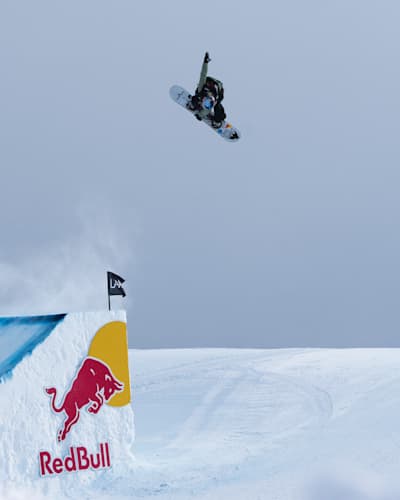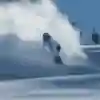
Snowboarding
Here's how a snowboard slopestyle competition is judged
In a world where Triple Corks have become the norm, differentiating between slopestyle snowboarding's top athletes can be hard to wrap your head around. Here's our breakdown on how judges do it.
Most competitive sporting events crown an objective winner: scoring more goals, crossing the finish line first, lifting more weight. Landing atop the podium is commonly the result of transparent and indisputable physical events.
Sports like slopestyle snowboarding aren't always that clear-cut however. Slopestyle snowboarding sees riders taking turns to tackle a course consisting of rails, jumps and other park features. Riders are scored on the difficulty and execution of tricks performed, as well as the amplitude achieved on each individual feature by a team of judges. The rider awarded with the highest score wins the contest.
Alongside gymnastics, diving and figure skating, slopestyle snowboarding is a mainstream judged sport that measures degrees of technical performance or artistic impression. Style effectively. This adds an element of subjectivity and scoring can thus fall victim to personal opinion or taste.

8 min
Slopestyle highlights
Check out the best of the action at the men's and women's hotly-contested slopestyle events at Laax 2022.
To ensure fair competition, slopestyle snowboarding is governed by a set of rules and customs familiarised by the International Ski Federation (FIS). Judges with a wealth of experience in the world of snowboarding distinguish between athletes based on six criteria: amplitude, trick difficulty, execution, variation, style and combination.
From Yuki Kadono's back to back Triple Cork 1620s at the 2015 Burton US Open, to Mark McMorris's highest score in snowboard slopestyle history at the 2013 X Games, slopestyle snowboarding continues to evolve into one of the most innovative and risky competitive sports in history. While the level of talent has reached an all-time high, it's essential to understand what sets one rider apart from another.
Here's everything you need to know about how a slopestyle snowboard competition is judged.
01
How are the big comps decided?
The most common slopestyle judging format adheres to the standards set by the FIS, the world's highest governing body for international winter sports.
Competitions like the Laax Open and the Burton US Open use an easy-to-follow, FIS-inspired judging system that dissects each individual trick, as well as each riders overall impression throughout the entire run. Riders are allowed two or three runs through the course, in a winner-takes-all format. Following the run, each rider is presented an explicit score and breakdown of their run.
Total trick score (60%) plus the overall impression score (40%) adds up to the rider's score.
02
Rules and judging at a glance
Breaking down the total trick score
The total trick score makes up 60 percent of the final score of each run. Pairs of individual trick judges are assigned to each feature throughout the entire course, each of which has a set value. Judges only focus on one jump or rail section and assign riders a score from 1–10 based on amplitude, trick difficulty and execution. Individual trick scores are then added up for a total trick score.
By breaking down the course into valued features, judges aim to enhance transparency, so that riders can better understand their strengths and weaknesses throughout their entire run.
Using Yuki Kadono and Dusty Henricksen's podium runs from the 2020 Burton US Open as an example, here’s how the total trick score breakdown works.
Both runs listed above are full of progressive, mind-blowing individual tricks, but why did Kadono finish 4.2 points ahead of Hendrickson on the total trick score? To better understand, let’s look more closely at the judging criteria: amplitude, trick difficulty and execution.
Amplitude
This factor refers to a rider's flow over a feature. Judges want to see riders entering each feature with appropriate speed, perform a clean pop off the take-off and demonstrate a high arc and trajectory through the air to maximize airtime. For example, Kadono's Backside 1260 Melon demonstrated a higher trajectory and more loft than Hendrickson's Switch Frontside 900 Double Cork, so this additional amplitude benefited Kadono's individual trick score.
Trick difficulty
Trick difficulty is clearly communicated with coaches and riders at the judges meeting prior to any competition. It can be based on the number of rotations, direction of rotations, axis, blind landings and grabs. Scoring also takes progression into consideration, so a new or uncommon maneuver will be rewarded accordingly.
Objectively, some tricks are harder and more innovative than others. The highest scoring individual trick from the 2020 Burton US Open was Hendrickson’s Backside 1800 Quad Cork Mute. Spinning five full rotations, corking the spin four times and riding away clean. Only a handful of riders would even consider attempting that trick.
Hendrickson may have scored a 9.8 on that final jump, but he scored a 6.9 on the first feature and a 7.4 on the third, which significantly decreased his overall average. Kadono, on the other hand, averaged higher scores throughout the entire course.
Execution
High scoring execution demonstrates full control, stability and mastery throughout the entire trick. Style is key. This means adequate pop off the lip, limited premature spinning – unless it's intentional – a high arcing trajectory and grabs that are held throughout the majority of the trick. In the rail sections, all tricks should be properly locked in, controlled and completed to the end of the feature.
For example, Kadono’s Switch Backside 270 On 270 Out below landed him an 8.5 because it was executed with ease. The take-off was timed perfectly, he slid the entire rail and both spins on and off were fully controlled.
Judges use these criteria to decipher between tricks and rank them accordingly. However, when two rider's perform the same trick with equal execution, a judge's subjective perspective comes into play.
The remaining 40 percent of a rider’s overall score is based on the overall impression score.
03
Breaking down the overall impression score
While a pair of judges are assigned to each individual feature, two overall impression judges are responsible for evaluating the entire run as a whole. These judges focus on variation, style and combinations from feature-to-feature. They are looking for differentiation between features and tricks, effortless execution from start to finish and the overall usage and composition of the run.
To better understand the overall impression score, lets look in more detail at the following terms: variation, style and combination.
Variation
When it comes to variation, judges award a well-rounded rider who can mix in a variety of trick types into their run. This can range from spinning in all four directions, demonstrating a variety of grabs and tweaks, a mix of flat spins and corks, as well as the ability to utilise creative features and lines throughout the run.
Style
A riders style is key to any winning slopestyle run. Though it's subjective, style represents the unique flare, aesthetic or artistic movement that a rider adds to the execution of each trick. When style is emphasised by a rider, it displays true mastery of a trick.
Combination
Combination refers to the sequence of tricks and how they're linked together in a run. A more difficult combination includes a high degree of variation, as well as demonstrating harder and riskier tricks at the beginning or middle of the run.
If you want to win contests, you'd better have your rail riding on point
© Lorenz Richard/Red Bull Content Pool
04
Jam session-style judging
Up until 2020, the X Games Aspen slopestyle judging regime mirrored that of other major competitions. That year however the event adopted a 'jam' competition format, which doesn’t rank riders according to their individual best run, but rather their overall performance throughout the entire contest.
One after another, riders run through the course for a set amount of time. Unofficial rankings are displayed after each finished run and once the time limit expires, the scoreboard presents the ranking of the athletes. Riders are ranked using the same judging criteria as defined by FIS standards, but don't receive scores, thus reducing judging transparency.
On it's debut at the X Games, the jam format received mixed responses. The format change aimed to reduce the pressure on athletes to land their best possible run, eliminate the 'throwaway run' and minimise judging delays. However, with no scores or score breakdowns, the transition made it difficult for riders and coaches to know how to win.
Now you know all about how to judge snowboard slopestyle comps, put your new-found knowledge to the test and tune-in to the world renowned Laax Open on January 20-21 live on Red Bull TV.
Part of this story











